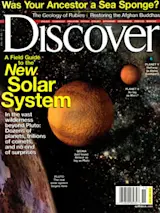The blackout of 2003 upset a lot of routines, but Lackson Marufu of the University of Maryland was thrilled to divert his scheduled air-quality monitoring flight over eastern Maryland. He relocated to Selinsgrove, a Pennsylvania town in the middle of the blackout area, which happens to be downwind of more than 100 Ohio River valley power plants. “It was a unique opportunity to quantify directly, and for the very first time, the contribution of power plants to regional air quality,” he says.
Marufu’s samples show that coal-burning power plants produce a bigger-than-expected share of the chemical cocktail that people in the northeastern United States inhale every day. Within 24 hours of the blackout, sulfur dioxide levels dropped by 90 percent, and ozone declined by 50 percent. Both chemicals are linked to global climate change, lung disease, and increased mortality rates. Daytime visibility in the region during the blackout increased by nearly 25 miles due to a 70 percent decrease in light-scattering particles. Tall smokestacks, built to alleviate pollution close to power plants, may contribute to the regional air problem by causing emissions to stay suspended long enough to react and produce other, more harmful pollutants. At least Marufu sees a silver lining in his smoggy data: “If effective control measures are implemented, the results would be immediate.”














